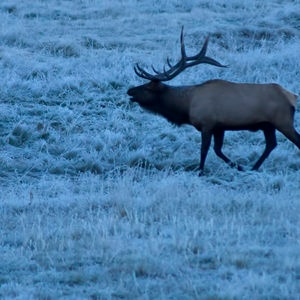 Wow, look at the rack on that … elk, of course. But a rack of what? We tend to use the terms “horns” and “antlers” interchangeably, but they are really very different structures. A common misconception is that since they look similar and grow from animals’ heads, that they must be the same. Well they are actually quite different.
Wow, look at the rack on that … elk, of course. But a rack of what? We tend to use the terms “horns” and “antlers” interchangeably, but they are really very different structures. A common misconception is that since they look similar and grow from animals’ heads, that they must be the same. Well they are actually quite different.
We will start off with antlers. We see antlers on the male of animals such as mule deer, elk, and moose. Each one of these animals grows a set of antlers every year, but will shed them off after every mating season, generally between January and April. Antlers are grown in order to protect the animals from predators and other males during mating season. They are made from bone that is an extension from their skull! This will cause the animals a significant amount of pain during the summer months when the antlers are growing. Luckily male deer and elk have found a stash of natural aspirin in the bark of the aspen. While hiking around the Eagle-Vail area you might come across an aspen grove with large dark marks on them. These marks are from these animals chewing on the bark to get the natural aspirin which are supposed to help reduce these growing pains. Antlers grow back every year a little differently, and with age, antlers will grow larger as well. The older the animal, the longer the antler will be and the more spikes it will grow. By the age of eleven or twelve, the antlers will be at their peak growth and will not grow any larger.
Now horns are used for the many of the same reasons as antlers, for protection and during the mating season, but they are different in that they are not shed each year. They are found on pronghorn, bighorn sheep, and bison. The horn has two parts to it, compared to the singular antler. Horns have an interior extension that grows directly from the skull and an outer sheath around the interior extension. The interior is made of bone, similar to the antler, but the outer sheath is made from keratin, special hair follicles similar to our fingernails. Horns, as mentioned previously, are not shed annually, but keep growing throughout an animal’s life, except for pronghorn whose outer sheath falls off every year and grows back around the interior extension. Horns are also constantly growing throughout the animal’s life, it is difficult to determine the exact age of the animal by their horns, but we can determine if it is an older or younger animal by how long the horns are. Horns are also different in the sense that if they are damaged, they will not grow back.
Horns and antlers are incredible features that often invoke our creative and artistic side, and people will commonly collect them, either finding them by chance, or deliberately setting out in search of the antler’s characteristic curve. But we also have to remember that they are in nature for a reason. When antlers, and in some cases, horns, are shed, they are used by other organisms. They are made of almost all calcium which is a mineral that is hard to come by for many smaller animals, but also a necessary one. These smaller animals will chew on these fallen horns and antlers to give them the nourishment they need. So it’s always better to leave the antlers on the ground and let nature take its course.
So as the leaves begin to fall and we catch glimpses of the horned and antlered beasts migrating to their winter grounds, keep in mind that these beautiful and intricate head pieces are all part of the eternal cycle of nutrients and energy, like all of us.
Cyrus Brown is a Naturalist at the Walking Mountains Science Center who is originally from Seattle Washington. He enjoys educating all ages about the environment and taking them on nature walks and hikes.









